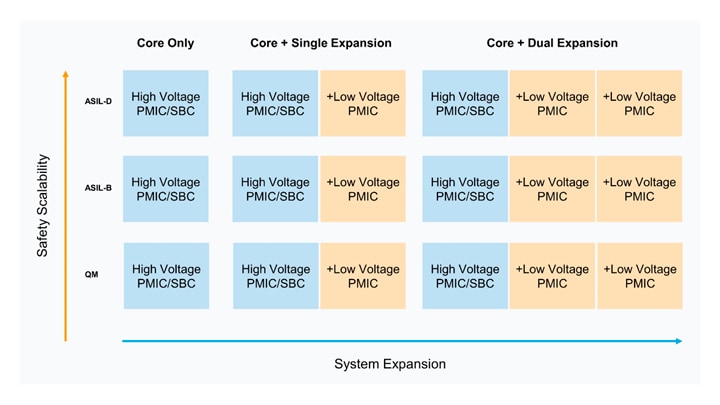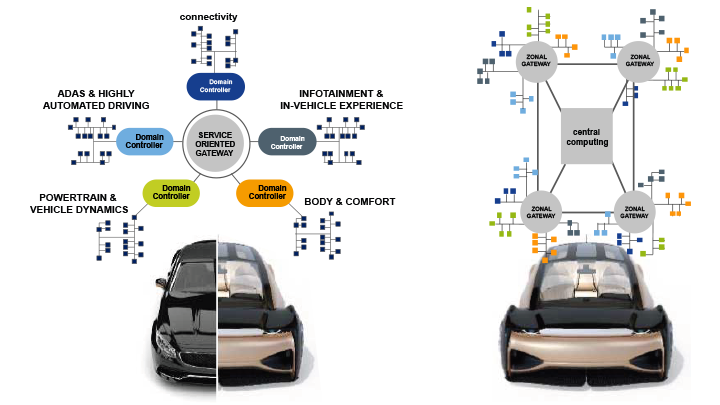Specifying a power management approach for a given microcontroller and peripherals on an
electronic control unit (ECU) used to be relatively easy. However, with the exponential growth in
automotive system complexity, designers face numerous challenges. They now need devices that are
intuitive, interchangeable and able to facilitate platform development for power management and
safety.
Automotive system complexity continues to rise with the use of high-computing-performance MCUs and
system-on-chips (SoCs) to deliver innovative applications and features, such as electrification,
ADAS and zonal domain controllers. But how do you power all the different processors and system
peripherals or high computing SoCs, safely and efficiently while simultaneously enabling complex
power-up and power-down sequences, simplifying board design, incorporating scalability and
reducing the risk of reliability failures caused by power hotspots. To answer these questions,
let’s analyze some key elements of the power management approach.
Power Management ICs or Discretes
Nowadays, the automotive industry's fast pace means designs are replicated across an entire family
of vehicles with slight variations. Processors are selected first, and then the power management
aspect. A discrete approach offers power scalability and flexibility in the placement and board
layout, but as the solution becomes more complex, other components such as a sequencer, voltage
monitoring and the need of diagnostics are required. Also a small safety MCU with its software to
manage the watchdog and system safety reaction could be required. A power management IC (PMIC) or
a system basis chip (SBC) based solution would support this complete set of features in one device
without compromise on scalability and are easy to design.
SBCs and PMICs for a Power Supply Platform
The decision is made to use an SBC IC or a PMIC for the increased complexity in automotive
systems. And due to the different systems, there is the need to transfer power from the battery to
multiple low-voltage domains. Switching to a distributed power architecture solves many of the
design limitations of the 12 V/24 V main battery supply and standard 5 V automotive supply rail.
In a distributed power architecture, high-voltage SBC/PMICs (12/24 V) and multiple low-voltage
PMICs (5 V) can be combined and configured to deliver a range of supply rails for a host of power
needs. Additional rails can be created simply by expanding the number of low-voltage PMICs still
powered by our high-voltage SBC/PMICs.

Functional Safety Across the Board
At NXP, we are well aware about system safety requirements that hardware engineers must satisfy.
That’s why we developed our
BYLink
solution considering a high safety integrity level for our smart safety mechanisms. Our portfolio
is composed of different pin- and-software compatible IC flavour to enable customer platform
approach and to satisfy different safety requirements such as: QM / ASIL B, and ASIL D. With a
multi-PMIC system solution and thanks to the BYLink concept, the safety integration is
facilitated, removing all barriers that such complex safety systems can bring. While individual
low-voltage PMICs can be QM or ASIL B rated, the whole power domain ECU can gain ASIL D level
through the primary high-voltage PMIC since it is responsible to monitor the critical voltages and
the safety MCU, plus transition the system into safe state in case of system failure.

Synchronized Sequencing
Another challenge of system complexity is the synchronization of the power-up and power-down
sequence needed to initialize different controllers and peripherals. A programmable power up/down
sequencer embedded in each device which can be configured to fine-tune the sequence time is an
ideal option for flexibility and minimizing as well system BOM.
How should devices be synchronized in a distributed architecture?
NXP’s new BYLink concept helps ensure the synchronization between all devices to avoid any
external additional components. This reliable and cost effective solution allows for individual
devices to be physically separated, reducing major heat spots since thermal management is at ECU
level.

NXP’s Safe, Scalable, Expandable BYLink System Power Platform Is the Answer
Enabling scalable power rails in a common IC footprint, which also share a familiar configuration
interface for software portability between devices. These power management building blocks provide
design flexibility and scalability with cascaded system PMICs essentially behaving as a single
power supply solution. With the new BYLink platform we are able to offer an easy and vital link
towards a safe and configurable power management design.
To learn more about the BYLink platform, read the
whitepaper.







